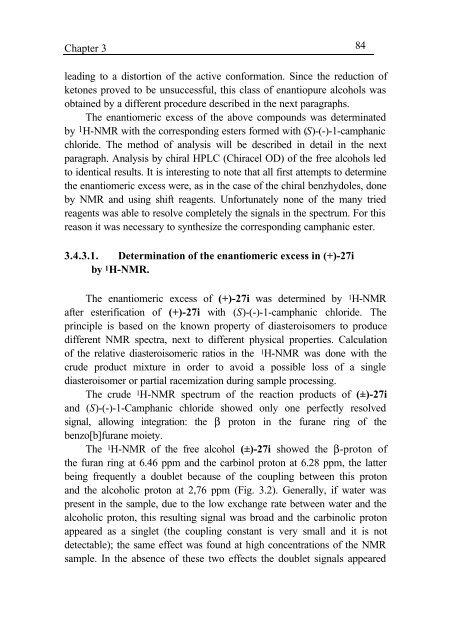Advances in the stereoselective synthesis of antifungal agents and ...
Advances in the stereoselective synthesis of antifungal agents and ...
Advances in the stereoselective synthesis of antifungal agents and ...
Create successful ePaper yourself
Turn your PDF publications into a flip-book with our unique Google optimized e-Paper software.
Chapter 3 84lead<strong>in</strong>g to a distortion <strong>of</strong> <strong>the</strong> active conformation. S<strong>in</strong>ce <strong>the</strong> reduction <strong>of</strong>ketones proved to be unsuccessful, this class <strong>of</strong> enantiopure alcohols wasobta<strong>in</strong>ed by a different procedure described <strong>in</strong> <strong>the</strong> next paragraphs.The enantiomeric excess <strong>of</strong> <strong>the</strong> above compounds was determ<strong>in</strong>atedby 1 H-NMR with <strong>the</strong> correspond<strong>in</strong>g esters formed with (S)-(-)-1-camphanicchloride. The method <strong>of</strong> analysis will be described <strong>in</strong> detail <strong>in</strong> <strong>the</strong> nextparagraph. Analysis by chiral HPLC (Chiracel OD) <strong>of</strong> <strong>the</strong> free alcohols ledto identical results. It is <strong>in</strong>terest<strong>in</strong>g to note that all first attempts to determ<strong>in</strong>e<strong>the</strong> enantiomeric excess were, as <strong>in</strong> <strong>the</strong> case <strong>of</strong> <strong>the</strong> chiral benzhydoles, doneby NMR <strong>and</strong> us<strong>in</strong>g shift re<strong>agents</strong>. Unfortunately none <strong>of</strong> <strong>the</strong> many triedre<strong>agents</strong> was able to resolve completely <strong>the</strong> signals <strong>in</strong> <strong>the</strong> spectrum. For thisreason it was necessary to syn<strong>the</strong>size <strong>the</strong> correspond<strong>in</strong>g camphanic ester.3.4.3.1. Determ<strong>in</strong>ation <strong>of</strong> <strong>the</strong> enantiomeric excess <strong>in</strong> (+)-27iby 1 H-NMR.The enantiomeric excess <strong>of</strong> (+)-27i was determ<strong>in</strong>ed by 1 H-NMRafter esterification <strong>of</strong> (+)-27i with (S)-(-)-1-camphanic chloride. Thepr<strong>in</strong>ciple is based on <strong>the</strong> known property <strong>of</strong> diasteroisomers to producedifferent NMR spectra, next to different physical properties. Calculation<strong>of</strong> <strong>the</strong> relative diasteroisomeric ratios <strong>in</strong> <strong>the</strong> 1 H-NMR was done with <strong>the</strong>crude product mixture <strong>in</strong> order to avoid a possible loss <strong>of</strong> a s<strong>in</strong>glediasteroisomer or partial racemization dur<strong>in</strong>g sample process<strong>in</strong>g.The crude 1 H-NMR spectrum <strong>of</strong> <strong>the</strong> reaction products <strong>of</strong> (±)-27i<strong>and</strong> (S)-(-)-1-Camphanic chloride showed only one perfectly resolvedsignal, allow<strong>in</strong>g <strong>in</strong>tegration: <strong>the</strong> β proton <strong>in</strong> <strong>the</strong> furane r<strong>in</strong>g <strong>of</strong> <strong>the</strong>benzo[b]furane moiety.The 1 H-NMR <strong>of</strong> <strong>the</strong> free alcohol (±)-27i showed <strong>the</strong> β-proton <strong>of</strong><strong>the</strong> furan r<strong>in</strong>g at 6.46 ppm <strong>and</strong> <strong>the</strong> carb<strong>in</strong>ol proton at 6.28 ppm, <strong>the</strong> latterbe<strong>in</strong>g frequently a doublet because <strong>of</strong> <strong>the</strong> coupl<strong>in</strong>g between this proton<strong>and</strong> <strong>the</strong> alcoholic proton at 2,76 ppm (Fig. 3.2). Generally, if water waspresent <strong>in</strong> <strong>the</strong> sample, due to <strong>the</strong> low exchange rate between water <strong>and</strong> <strong>the</strong>alcoholic proton, this result<strong>in</strong>g signal was broad <strong>and</strong> <strong>the</strong> carb<strong>in</strong>olic protonappeared as a s<strong>in</strong>glet (<strong>the</strong> coupl<strong>in</strong>g constant is very small <strong>and</strong> it is notdetectable); <strong>the</strong> same effect was found at high concentrations <strong>of</strong> <strong>the</strong> NMRsample. In <strong>the</strong> absence <strong>of</strong> <strong>the</strong>se two effects <strong>the</strong> doublet signals appeared















